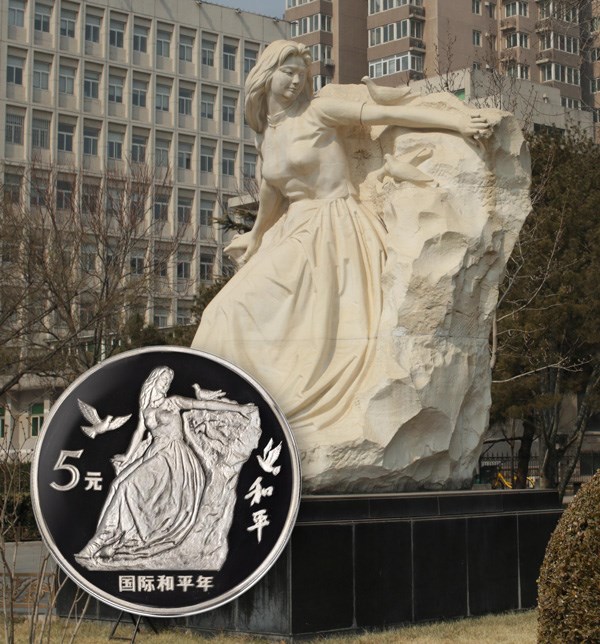Chinese Coins: Much Better Late Than Never
Posted on 4/10/2018
By
Peter Anthony
The calendar said “Spring,” but Beijing’s weather kept insisting “Winter.” It was March already, yet the temperature at night was below freezing. Darkness had fallen while I had dinner, and Fuxingmen subway station’s entrance was ever so conveniently located nearby. A quick one-station hop and a nice, warm hotel room awaited. I braced for the cold, stepped outside and, on a restless whim, turned my back to Fuxingmen. The bright lights of “Rainbow Bridge,” a three-minute walk away, beckoned. The bridge spans a freeway. It’s called Rainbow because of an arc of brilliant multicolored LED lights across one end.
A couple of young security guards in heavy green wool coats were stationed there. To my “Ni hao,” they echoed “Ni hao,”and smiled at the foreigner. The midpoint of the bridge is a good spot to take photos of the traffic below. As I stood, there a young woman pushed a bundled-up boy in a stroller toward me.
“Hello,” she said in English. “Where are you from?”
“Meigua, the USA,” I answered.
“Are you here on business? Do you like China?”
We chatted and walked together toward the span’s other side. As soon as we reached it, I looked up and stopped. Before me, a large white stone figure of a woman shone dimly in the lamplight. It was the Year of Peace statue. For years, no one I asked could tell me where to find it.
The Year of Peace was declared to mark the 40th anniversary of the United Nations in 1986. During that year, among other events, peace conferences were held in Honolulu, London and New Delhi; a symposium on Peace took place in Mannheim, Germany, and a festival in Moscow.
In 1986, many countries issued coins for the celebration, China included. The country minted 1,000 1/3 oz. gold and 1,500 27 gram silver International Year of Peace commemoratives. Both are highly sought after by collectors.
Martin Weiss, the founder of Panda America, which was the largest distributor of Panda coins in the world at the time, recalls that he could never get the coins. “They were sold very quietly in Europe. It was a soft distribution and then they were gone.”
How did they get to Europe? Another American dealer provides some clues. “It was not until around 1988 that these coins appeared on the market. Wei Tai, who had a small coin shop in Hong Kong, China, but was actually the top dealer in the city at the time, had them. He had the entire mintage of gold coins and around 300 of the silvers in his store.”
“I bought everything he had at not much above melt value. Wei Tai had a very good relationship with Great Wall, the China Mint’s official distributor in Hong Kong, China. At the price he sold them to me — and two years late — I guessed that was his source, but he never told me that. I also guessed that something had gone wrong with the original distribution plan, and that is how the coins ended up in his hands.”
“I turned around and sold them all to a German coin company. That may explain why there were so many in Europe.”
 |
| The 1986 27 gram silver 5 Yuan International Year of Peace coin along with a statue in Beijing. |
I turned to the lady with the stroller and said, “This statue is famous.”
“Really?”
“Yes.”
“I didn’t know.”
“It is the ‘Year of Peace’ statue. It was on some coins.”
“Oh!”
After a few more words, we said good night and she pushed her stroller into the night. That is not the end of the story, though. The following day, I came back during daylight hours to get some better photos.
In the sunshine, the statue looked as though it was cast in plaster, or some similar material, which struck me as a bit odd for such an important piece of art. At first glance, there was nothing to identify it, which was also strange. Finally, I saw a small black plaque in the rear at the bottom of the base. In Chinese, this told that the figure in the park is a copy of the Year of Peace sculpture. The original was sent to Japan as a peace gift by China and today resides in Osaka, Japan. And that is where the model now rests for a pair of Chinese coins that were much better released late than never.
Peter Anthony is an expert on Chinese modern coins with a particular focus on Panda coins. He is an analyst for the NGC Chinese Modern Coin Price Guide as well as a consultant on Chinese modern coins.
Stay Informed
Want news like this delivered to your inbox once a month? Subscribe to the free NGC eNewsletter today!
